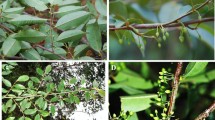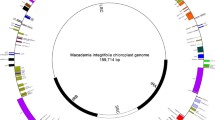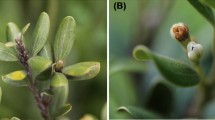Abstract
The complete plastid genome of Castanea pumila L. Mill. var. pumila, the Allegheny chinkapin, was generated using next-generation sequencing of the leaf transcriptome of the species and fill-ins of missing regions via Sanger sequencing. The chloroplast (cp) genome of C. pumila showed high homology (99.8 %) to the genome of Castanea mollissima (the Chinese chestnut, 600,799 bp) in overall gene organization and size (160, 603 bp). Castanea dentata 454 sequence data (www.fagaceae.org) were used to generate a partial chloroplast genome of the American chestnut (93 % coverage). Comparisons of the cp genomes of the American and Chinese Castanea species indicated that the species shared 68.0 % of the mutations at coding and intronic regions, while 18.0 % of the mutations were specific to C. pumila and 13.9 % to C. dentata. The loss and nuclear localization of the rpl22 gene was similarly a feature of the genome of the American Castanea species. Since a higher number of mutational events separated C. pumila from C. mollissima, a more recent divergence of C. dentata from a common ancestor was hypothesized.


Similar content being viewed by others
References
Alexander LW, Woeste KE (2014) Pyrosequencing of the northern red oak (Quercus rubra L.) chloroplast genome reveals high quality polymorphisms for population management. Tree Genet Genomes 10:803–812
Dane F (2009) Comparative phylogeography of Castanea species. Acta Horticulturae 866:211–222
Dane F, Lang P (2008) Biodiversity and evolution of Castanea. In: Sharma AK, Sharma A (eds) Plant genome biodiversity and evolution. Phanerograms (Gymnosperm) and (Angiosperm-Monocotyledons). Chapter 4. Science Publishers, Enfield, NH, pp 79–100
Dane F, Sisco PH (2014) Genetic diversity of American chestnut is highest in the southern US: the evidence from nuclear and chloroplast DNA studies. J Amer Chestnut Found 28:9–13
Huang HW, Dane F, Kubisiak TL (1998) Allozyme and RAPD analysis of the genetic diversity and geographic variation in wild populations of the American chestnut (Fagaceae). Amer J Bot 85:1013–1021
Jansen RK, Cai Z, Raubeson LA, Daniell H, de Pamphilis CW, Leebens-Mack J, Muller KF, Guisinger-Bellian M, Haberle RC, Hansen AK, Chumley TW, Lee SB, Peery R, McNeal JR, Kuehl JV, Boore JL (2007) Analysis of 81 genes from 64 plastid genomes resolves relationships in angiosperms and identifies genome-scale evolutionary patterns. Proc Natl Acad Sci U S A 104:19369–19374
Jansen RK, Saski C, Lee S-B, Hansen AK, Daniell H (2011) Complete plastic genome sequences of three rosids (Castanea, Prunus, Theobroma): evidence for at least two independent transfers of rpl22 to the nucleus. Mol Biol Evol 28:835–847
Jansen RK, Ruhlman TA (2012) Genomics of chloroplasts and mitochondria. Chapter 5. In: Bock R, Knoop V (eds) Plastid genomes of seed plants. Springer E-Book
Jaynes R (1975) Chestnut. In: Moore J (ed) Advances in fruit breeding. Purdue University Press IN, pp 490–503
Johnson GP (1988) Revision of Castanea sect. Balanocastanon (Fagaceae). J Arnold Arboretum 69:25–49
Kremer A, Abbott AG, Carlson JE, Manos PS, Plomion C, Sisco P, Staton ME, Ueno S, Venramin GG (2012) Genomics of Fagaceae. Tree Genet Genomes 8:583–610
Lang P, Dane F, Kubisiak TL, Huang HW (2007) Molecular evidence for an Asian origin and a unique westward migration of species in the genus Castanea via Europe to North America. Mol Phylogenet Evol 43:49–59
Li X, Dane F (2013) Comparative chloroplast and nuclear DNA analysis of Castanea species in the southern region of the USA. Tree Genet Genomes 9:107–116
Li H, Handsaker B, Wysoker A, Fennell T, Ruan J, Homer N, Marth G, Abecasis G, Durbin R, 1000 Genome Project Data Processing Subgroup (2009) The sequence alignment/map (SAM) format and SAMtools. Bioinformatics 25:2078–2079
Liu C, Shi L, Zhu Y, Chen H, Zhang J, Lin X, Guan X (2012) CpGAVAS, an integrated web server for the annotation, visualization, analysis and GenBank submission of completely sequenced chloroplast genome sequences. BMC Genomics 13:715
Magee AM, Aspinall S, Rice DW, Cusack BP, Semon M, Perry AS, Stefanovic S, Milbourne D, Barth S, Palmer JD, Gray JC, Kavanagh TA, Wolfe KH (2010) Localized hypermutation and associated gene losses in legume chloroplast genomes. Genome Res 20:1700–1710
Matsuoka Y, Yamazaki Y, Ogijhara Y, Tsunewaki K (2002) Whole chloroplast genome comparison of rice, maize and wheat: implications for chloroplast gene diversification and phylogeny of cereals. Mol Biol Evol 19:2084–2091
Milne I, Stephen G, Bayer M, Cock PJ, Prichard L, Cardle L, Shaw PD, Marshall D (2013) Using Tablet for visual exploration of second-generation sequencing data. Brief Bioinform 14:192–202
Paillet FL (1993) Growth form and life-histories of American chestnut and Allegheny and Ozark chinquapin at various North American sites. Bull Torrey Bot Club 120:257–268
Payne J, Miller G, Johnson GP, Senter SD (1994) Castanea pumila (L.) Mill: an underused native nut tree. Hortscience 29:62–131
Pleines T, Jakob SS, Blattner FR (2009) Application of non-coding DNA regions in intraspecific analyses. Plant Syst Evol 282:281–294
Rumble SM, Lacroute P, Dalca AV, Flume M, Sidow A, Brudno M (2009) SHRiMP: accurate mapping of short color-space reads. Plos Comput Biol 5:e1000386
Shaw J, Craddock JH, Binkley MA (2012) Phylogeny and phylogeography of North American Castanea Mill. (Fagaceae) using cpDNA suggests gene sharing in the southern Appalachian (Castanea Mill., Fagaceae). Castanea 77:186–211
Straub SCK, Fishbein M, Livshultz T, Foster Z, Parks M, Weitemier K, Cronn RC, Liston A (2011) Building a model: developing genomic resources for common milkweed (Asclepias syriaca) with low coverage genome sequencing. BMC Genomics 12:211
Wall PK, Leebens-Mack J, Chanderbali AS, Barakat A, Wolcott E, Liang H, Landherr L, Tomsho LP, Hu Y, Carlson JE, Ma H, Schuster SC, Soltis DE, Soltis PS, Altman N, de Pamphilis CW (2009) Comparison of next-generation sequencing technologies for transcriptome characterization. BMC Genomics 10:347
Wan CY, Wilkins TA (1994) A modified hot borate method significantly enhances the yield of high-quality RNA from cotton (Gossypium hirsutum L.,). Anal Biochem 223:7–12
Wyman SK, Jansen RK, Boore JL (2004) Automatic annotation of organellar genomes with DOGMA. Bioinform 20:3252–3255
Yang Z, Yoder AD (1999) Estimation of the transition/transversion rate bias and species sampling. J Mol Evol 48:274–283
Acknowledgments
This project was partially funded by the American Chestnut Foundation.
Data archiving statement
The C. pumila var. pumila chloroplast DNA sequence has been deposited in the NCBI nucleotide database under accession number KM360048.
Author information
Authors and Affiliations
Corresponding author
Additional information
Communicated by R. Sederoff
Rights and permissions
About this article
Cite this article
Dane, F., Wang, Z. & Goertzen, L. Analysis of the complete chloroplast genome of Castanea pumila var. pumila, the Allegheny chinkapin. Tree Genetics & Genomes 11, 14 (2015). https://doi.org/10.1007/s11295-015-0840-7
Received:
Revised:
Accepted:
Published:
DOI: https://doi.org/10.1007/s11295-015-0840-7




